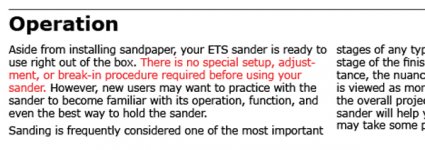Tim Raleigh said:Alex said:On higher settings it would behave erratically, jump around and stutter.
Ok, let me say I am not doubting you but I am curious as to why this lack of power would translate into a jumpy stuttering machine.
Here's why from the Festool FAQ linked to by Alex above - I take this to mean the brushes do not make good contact and therefore the motor receives intermittent power. Not really a power line problem, but I think you get the idea....the jumpiness is caused by the motor fluctuating during use. Similar to a car engine with a bad fuel pump. The car will buck as if it is starting and stopping.
"All Festool 120 volt power tools use brush-type universal motors with self-seating brushes. These brushes are serrated on the surface with narrow triangular grooves. The grooved texture of this surface needs to be worn down to the solid carbon substrate before the tool will reach peak performance. This is called the break in period. During this break-in period the brush takes on the same cylindrical shape that perfectly matches the curvature of the spinning armature, resulting in full contact. Some of our tools need to be run for as long as 10 hours before the brushes take on this shape and the motor develops full power. Your sander will be susceptible to power line fluctuations during this period and may not run at a constant speed."

